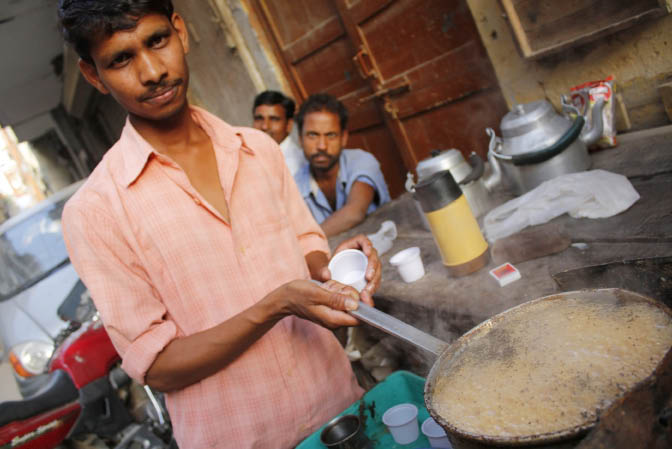Life
More Than Meets the Chai

It was a fresh, bright, Saturday, winter morning. My fiancée dropped me at the Patel Chawk Metro Station in New Delhi and left for work.
As a tea lover, I am attracted to the road-side tea stalls. My love for tea comes from my college life in Pune, which has chai stalls just about everywhere.
Delhi tea stalls are different. In and around Central Delhi, there are many juice shops on the footpaths. They look almost identical. They are painted yellow with a firm wooden structure that is half open on three sides and fully open on the fourth, with “Juice Corner” painted in red on the front. It has a list of juices, glued to corner of the counter, slightly askew. The menu list is a sham. That’s not all this shop is about. On looking closer, you discover that this mini juice shop is a shopping parlor with at least five other shops within the juice shop. Yes, at least five, some even manage seven, effectively and efficiently.
The juice shop I have walked up to is five meters adjacent to Patel Chawk Metro Station. There are two on this side of the road and two right across. They are all identical, almost like mirror images of each other. A young man, 23, with headphones plugged in his ears, is frying samosas. Tempting indeed, but you know I was looking for tea.
 I walk up to him and ask, “chai milegi” (Do you serve tea here?). He points to the rear of the stall, where I see a man making tea. The price is Rs 7.
I walk up to him and ask, “chai milegi” (Do you serve tea here?). He points to the rear of the stall, where I see a man making tea. The price is Rs 7.
The next few minutes stun me. The juice shop is a shopping mall, of sorts. It has eight mini-shops within it, with both food and non-food items for sale.
The front of the shop is for juice lovers and the variety (on paper) is commendable. From carrot and coriander to orange and mix fruit, it can serve up drinks for every taste bud. Now imagine a shop stocked with all these vegetables, fruits, cutlery and equipment. One could learn space management and physics of balance in a whole new way.
In the front right corner of the juice shop is a mini-shop for cigarettes, biscuits, chips, namkeen, chocolates, water bottles and newspapers — all of which are on display. A boy sitting on a stool on the right corner owns this small shop.
Then there is the man with the earphone, frying samosas. This time around, I notice how meticulously, he has boxes stocked on each other, leaning against the shop structure to display his trays of fried items, including five varieties of pakoras and samosas. He has a gas stove and all the basic ingredients for making his snacks very strategically stocked up in his extremely tight space. A set of two chairs comprise his kitchen. Marvelous use of space. I order a samosa. Tempting indeed!
To the left of the tea stall is a different world. There is my breed, lawyers, two of them, sitting with a type-writer, a laptop, an HP printer, a data cable, and an extension cord connected to the inside of the juice shop to run these gadgets. Yes, this is their office.
A stone slab on the top left end of the juice shop is covered with cartons used to deliver Bisleri bottles. The lawyers mark their territory with their style of dress, which makes them stand apart from the workers at the Juice Corner. The one on the laptop, wearing nerdy spectacles is printing E-Stamps for his clients.
The tea seller calls out for me, “Madam apki chai taiyaar hai.” His shop, to the right of the lawyers chambers, is probably the most profitable one, no offence to the lawyers.
Sipping my tea, I am startled by the noise of a pressure cooker. It comes from the back end of the juice shop. Seems I had missed the food joint within the juice shop. The menu was limited, but still elaborate for that small space. There was mini-lunch for Rs. 30 and other combinations as well — roti, sabzi, dal, chawal. The man cooking the vegetables had a helper chopping vegetables.
I paid the chai-wala and the samosa-wala. As I started to walk toward the metro station, I saw beddings and blankets tied with rope stocked on the top of the juice shop. Seems the workers at the juice shop slept in their little space, if they wanted. Eight people were thus entitled to sleep in and around the juice shop.
I am reminded of the B-H-C model from my economics. At this juice shop, B is for Bungalow — the multinationals in India — H is for Haveli — the indigenous companies in India — and C is for the Chawl system, where there is “more to a shop” and “more in a shop” than most of us can possibly imagine.

You must be logged in to post a comment Login